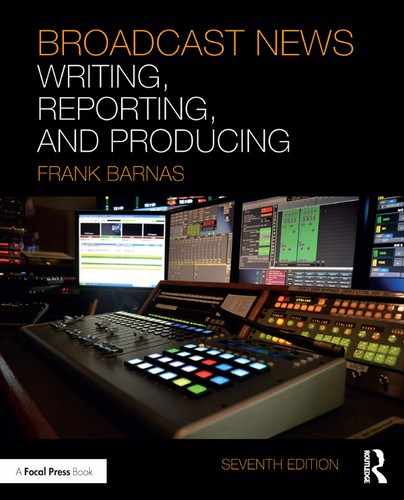CHAPTER 11
Covering Planned Events
CONTENTS
Interviewing Around the Press Conference
KEY WORDS
Cold Open
Feature Event
Grand Opening
Meeting
Objectivity
Political Campaign
Press Conference
Subjectivity
INTRODUCTION
On a slow day with no breaking stories and little spot news, planned events can save a newscast. The benefits of a planned event are easy to see: The location is given beforehand, the time and date are scheduled well in advance, background information of the event is given upfront, and phone numbers of the principal players are provided if anyone has questions.
All of these reasons can be summed up thus—planned events are the unique news stories to which the reporter has received an invitation. Spot news stories may show suffering or a criminal activity, while an enterprised story could reveal an investigation that shows someone in an unflattering manner. But a planned event, outlined beforehand with a press release, is a story that needs a reporter to fulfill its purpose of self-promotion.
There are literally thousands of corporations, politicians, special-interest groups, nonprofit organizations, government agencies, and other individuals and groups looking for exposure on network and local newscasts. Assignment desks are inundated with news releases and telephone calls from public relations firms and publicists working for these various groups. Naturally, most of these organizations have Internet websites, Facebook pages, and Twitter threads where newsrooms can reach them and vice versa.
Every one of these publicists tries to persuade the assignment staff that there is something special or important about the product, company, issue, or individual they represent. The assignment desk rejects most of these news releases and telephone calls for a variety of reasons. Often, the event is too commercial or has little or no news value. Other times, there simply is not enough airtime available to go around. However, some of these releases and telephone calls alert the assignment staff to events that are important and warrant coverage.
FAST FACT: In 1913, Woodrow Wilson was the first U.S. president to host a press conference where reporters were allowed to ask the president direct questions.
Gathering a crowd of journalists with digital cameras in one room is a triumph for anyone working in public relations. The number of journalists who attend such news conferences depends on what is being “sold.” Make no mistake about it, that is what we are talking about—“selling.”
This chapter discusses these events and describes why some of the events are newsworthy whereas others are not. City council meetings, which are planned events, may be tedious, yet have nuggets of information for the audience. Conversely, a showy press conference may have more visual impact but not the newsworthiness of the council meeting. Learning to gauge why to cover these stories and how to cover them well are the key elements of this chapter.
PRESS CONFERENCES
It makes no difference whether the news conference is called by a government official, a Broadway producer, a major corporation, or the Red Cross; each news conference has a message to sell to the viewer. For example, the local district attorney may call a meeting with the news media to announce the arrest of several organized-crime bosses. The arrest is news, of course, but the district attorney also wants to let everyone know what a good job she and the department are doing.
Not all news conferences are that hard hitting. If there is a local theater company, the producer may believe that the media will turn out to hear about a new show. To make it even more visual, the news release just happens to mention that the chorus line will be there in full costume.
Some news conferences are not visual at all, but they are important to the viewing audience. The local Red Cross chapter knows that it may have difficulty getting reporters to cover its news conference to discuss a blood shortage. Simply put, it’s not likely to provide good pictures for television or exciting sound bites for radio. The news conference may just earn a 20-second read story on the 6 o’clock news. You might wonder why a blood shortage is not considered an important story. It is, but it probably will get more attention from newspapers than from radio and television. It just isn’t a good broadcast story, as the lack of visuals hurts its chances of getting into the newscasts.
The underlying current of covering any press conference is to understand why you are there as a reporter. Press releases that are issued by public relations per sonnel convey subjectivity; they want you to portray the event favorably in your story. As a broadcast journalist, your goal is to present stories with a large degree of objectivity, meaning you approach the subject matter as neutrally as you can.
This is not to say that a reporter should dismiss all press conferences as mere opportunities to be a cheerleading mouthpiece for the organization. Instead, if the reporter acknowledges that he or she is at an event that promotes one point of view, they can achieve a more balanced story with a bit of effort.

FIGURE 11.1 JStone/Shutterstock.com
POLITICAL PRESS CONFERENCES
People are running for some political office just about everywhere. Most reporters find themselves covering a political campaign early in their career. Even small communities hold elections for mayor, sheriff, town supervisor, and numerous other positions. Reporters also cover the campaigns of candidates for the state legislature, for Congress, and for the presidency when those candidates visit the area. It’s even trickier when your market straddles two or more states and you’re expected to cover elections for different states on independent election cycles.
Covering politics can be one of the more interesting stories that reporters cover, although sometimes the politicians themselves are less than inspiring and the issues not very stimulating. Also, covering politicians can be frustrating because the candidates often skirt the real issues and get into name calling and personality assassination. Compounding the problem is that the public is often indifferent to politics, ranking their interest on the subject fairly low, below topics such as education, crime, and the environment.
The most important requirement for reporting on politics is remaining neutral. Regardless of how reporters feel personally about the candidates, they must maintain their objectivity. Assignment editors and news directors will not ask reporters what their politics are when they’re assigned to cover the campaign of a state assemblyperson. The reporters are expected to report fairly, without any bias, even if they think poorly of the candidate.
However, it is not unusual for reporters to find that they like some candidates after they have been on the road with them; reporters need to watch that this admiration doesn’t creep into their scripts. When it does, the reporter might not even be aware of it, but it can be painfully visible to the audience and other journalists.
When covering a candidate during a campaign, a political reporter should not just parrot the candidate’s speeches. If the candidate says the same things every place he or she goes, it would be appropriate for the reporter to point that out. It would be equally important for the reporter to note when candidates change their positions or tone depending on the kind of group they’re addressing. In 2016, then-presidential candidate Hillary Clinton was repeatedly caught faking a drawl while campaigning in the South while quickly reverting to a more neutral accent in the North. Reporters eagerly seized on the difference that her delivery style changed depending on the location, even though the bullet points in her speech remained consistent.
It follows that the reporter should also tell the audience things about the location of the speech and the crowd. Was the candidate speaking in a predominantly Republican or Democratic area? Was the crowd mostly white collar or blue collar? Obviously, if the candidate was Republican and she was addressing a crowd in an affluent area of the city, her reception could be expected to be warmer than in the inner city. Likewise, the opposite could be expected if the candidate was a Democrat.
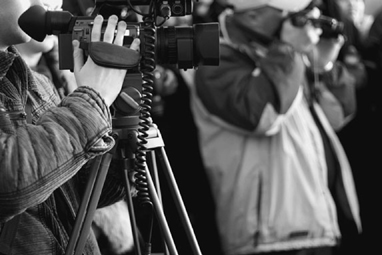
FIGURE 11.2 NiDerLander/iStockphoto.com
The crowd’s reaction is important. Was it enthusiastic or relatively quiet? Was the crowd large or small? If the weather affected the turnout, that should be noted. Did people challenge the candidate’s remarks? Did they seek out the candidate to shake his or her hand? Did the candidate take random questions from the audience or was everything screened in advance? It is this type of observational reporting that will elevate a political rally from mere theater to an insightful story worthy of the viewers’ time.
PROMOTIONAL PRESS CONFERENCES
Invariably, reporters will be called on to cover the ribbon cutting, ground breaking, or grand opening of a new store or manufacturing facility. The decision to cover these often depends on how big a facility it is. A tiny ice cream shop may not justify coverage, but the groundbreaking of a major manufac turing plant that will employ 3,500 people is a story that will leap into the A block.
While these events are planned, it is crucial to remember that the focal point of the event will only happen once. The ceremonial cutting of the ribbon must be captured on video; thus the videographer must be positioned and the camera rolling before scissors meet ribbon. Similarly, the tape must be recording before the ceremonial groundbreaking (which, bizarrely, will feature a slew of business folks in suits wearing hard hats in an open field). When events like these happen, it is often best to schedule the interviews immediately after the ribbon-cutting/grand-opening moment. If the interview is scheduled just before the big moment, you risk either missing the video or slowing down the entire event as everyone awaits you to release the subject from the interview. Grab them afterward.
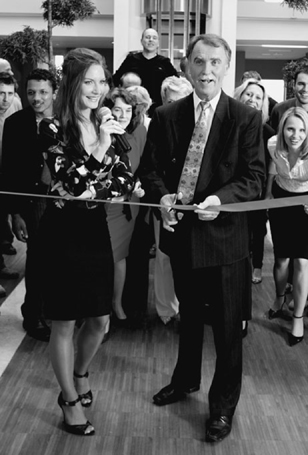
FIGURE 11.3 xavierarnau/iStockphoto.com
Feature Events
Covering hard news, whether spot news or planned events, is the “meat and potatoes” of broadcast journalism, whereas feature stories are the “dessert.” Those are the stories that often bring a smile and sometimes a tear to our faces.
Feature stories invariably end up near the bottom of the newscast, as coverage of the county fair or high school dance do not contain much hard-hitting journalism. No matter where a story may land in the rundown, reporters should still treat the subject matter and their interviewees with respect. It is far too easy for a “hard news” reporter to scoff at the accomplishments of a Cub Scout ceremony or a watermelon-eating contest. Just because a story may be on the lighter side is no reason to treat it with disdain. If nothing else, it gives the reporter and videographer the opportunity to be a bit more creative with their story.
EMERGENCY PRESS CONFERENCES
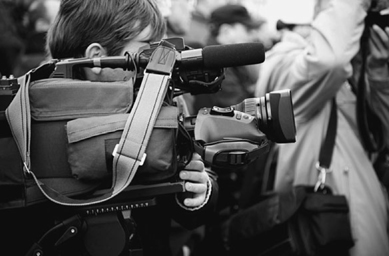
FIGURE 11.4 Kuzma/iStockphoto.com
Of all of the press conferences available, those that deal with emergencies most readily blur the distinction between spot news and planned events. Omar Mateen’s killing of 49 people at the Pulse nightclub in Orlando, the California wildfires of 2016, and count less natural and manmade disasters prompt officials to hold quick briefings with the press.
Unlike political and promotional events, emergency press conferences are hastily called with little advance notice. They are often spontaneous, in that a journalist will find a willing official to speak on camera for a quick moment. Within seconds, other reporters arrive, hungry for the latest news.
The abrupt nature of these press conferences is trying for both the subjects and the media. Questions and answers may be terse. The press conference may be interrupted by breaking developments or even stopped prematurely. For these reasons, reporters must be vigilant and extremely quick with their questions and note taking. Answers may not be repeated, clarification may not be given, and tempers can easily run short.
Despite the emotion behind the scenes, these press conferences serve a vital role for the audience. The officials use these opportunities to restore public trust and offer hope for the community. Emergency shelter locations may be given, providing a refuge for viewers. In case of an evacuation order, safe routes out of town will be provided by the officials. In short, this is not the time for reporters to take offense at a clipped answer or a terse response; the stressed viewers at home really don’t care about a reporter’s wounded ego during a crisis.
COVERING THE PRESS CONFERENCE
Since emergency press conferences are rare, we will focus this discussion on the common political and promotional press conferences. First, let’s look at a reporter preparing for a press announcement being held by the local district attorney. Depending on the sophistication of the newsroom, the reporter starts with the clips and video morgue to see what’s available on the arrested organized-crime figures. If there is video of them, she asks for it to be pulled. She reads carefully any clips on the arrested men and checks the Internet and websites for local newspapers. Before she leaves for the news conference, she also might make a quick check with other reporters in the newsroom to see if they have any additional information they gathered while covering other stories involving the men.
The reporter and her videographer arrive at the news conference early because it will be crowded and she wants to get a good position for her and the camera. When the conference begins, the DA reads a prepared statement. The cameras and tape recorders will be rolling, although little of the statement—and maybe none of it—will get on the air. The question-and-answer period following the opening statement usually produces the best sound bites.
The reporter keeps notes on the opening statement, in any case, so she will know where the best bites are if she decides to use any of them. She does the same when the question-and-answer period begins, keeping track of the time when the best comments are made. While she was reading the clips in the newsroom, the reporter noticed that the organized-crime leaders were arrested five years before. The DA—the same one—got a conviction, and the men were sentenced to ten to 20 years in prison. The reporter hopes that no one else beats her to the question she is ready to fire at the DA: “How come these guys aren’t still in prison? It’s only five years since you grabbed them and put them away the last time.” The question would surely be provocative, perhaps the answer would be one of the highlights of the news conference. In all likelihood, the DA would respond with something such as “I just convict them. Ask the judge and the parole board why they are back on the street so quickly.” The DA, who had been critical of the judiciary on several other occasions, provided anchors with the headline “DA Criticizes Judges and Parole Board.”
Sometimes it is important to ask tough questions. News conferences should not be just a forum for those calling them. It’s also important to ask follow-up questions, particularly when the individual holding the news conference is evasive or unclear. Techniques for asking good questions were discussed in Chapter 10, Interviewing. Remember, just because you received an invitation to a news conference does not mean you are restricted to asking softball questions. On the national scale, watching the White House Press Corps ask questions of the president at a press conference will reveal that some reporters are more timid whereas others are much more direct.
The coverage of planned events can bring out the best among competing news crews. It is common for news teams to loan batteries or share electrical cords with one another. Because covering a planned event can occupy a news crew for several hours, it is acceptable for news crews to share footage. After all, the footage recorded will look similar no matter who shoots it, plus no station will scoop the story from others. In cases like these, camaraderie among the news stations is to be admired.
INTERVIEWING AROUND THE PRESS CONFERENCE
Many broadcast reporters like to individually interview the person holding the news conference either before the event starts or after it is over. Some interview subjects agree; others refuse because they know it irritates other members of the media. This is particularly true when the reporter is still conducting the interview when the rest of the news corps arrives in the room. Other broadcast reporters, seeing what’s going on, tell their camera people to set up and start shooting. Suddenly, there’s a mini-news conference going on before the regular one starts.
Such occurrences are particularly offensive to print reporters, who then wait for the scheduled news conference to begin. Once the broadcast people have their interviews, it is not unusual for them to pack their gear and be on their way, leaving the person holding the news conference with just the newspaper people. Many broadcast reporters cover news conferences this way because their assignment editors tell them to be in and out of the news conference quickly so they can move on to other stories.
Doing an interview before a news conference has its risks. Another reporter may know something important that the early reporter missed in the one-on-one or a confrontation may occur when one of the print reporters asks an embarrassing question that catches the news conference host by surprise. The early reporter who came and went will not have this confrontation on tape.
FINDING WORKABLE VIDEO
Press conferences present their own problems for news coverage. In smaller markets, there may only be a handful of people in the room. In fact, a camera crew may find itself at a press conference with only the person who sent over the press release! Conversely, major stories in larger markets will attract a flock of news crews and spectators, thus limiting the physical space around the video cameras.
As mentioned earlier, finding a suitable spot to set up the camera is key. Your location should be with your back to any dominant exterior windows to prevent returning with shadowy footage. Ideally, you also want to set up near an exit; there is no joy in being pinned against a far wall when your newsroom texts you to cover a breaking story. Being near an exterior door also positions you between a potential interview subject and the exit allowing you to ask a question should they try to make a hasty retreat.
Veteran videographers will position themselves at the side of the room, not in the center. By shooting from the side, you have access to not only the lectern in the front, but also to shooting reaction shots of those in the audience. When the room is full of people, a simple strategy is to shoot reverse shots of various audience members as the speaker prepares; a quick handful of close-ups can be a lifesaver when editing later. Should the room be nearly vacant, it is not uncommon for one television crew to get reaction shots by videotaping the competition’s videographer.
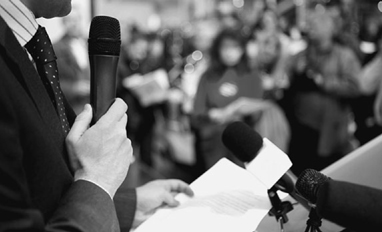
FIGURE 11.5 webphotographeer/iStockphoto.com
MEETINGS
Because of sunshine laws, it is easy for reporters to find out where meetings are happening, what items are on the agenda, and when the meetings will begin. City and county governments, local advisory boards, university planning sessions, and a host of other councils and groups routinely post their agendas on their websites. In fact, government meetings must be announced well in advance to prevent secret votes.
But while the work of city and town government is extremely important, it can also be one of the dullest assignments that radio and TV reporters cover. The problem for broadcast reporters is that deliberations of the city council, the board of supervisors, and other local officials often take hours. Still, the debated issues affect many people. An increase in local taxes, a curfew for teenagers, or a company’s effort to locate a waste disposal plant in a community brings out a big crowd and lots of journalists. Because such meetings can go on for hours and days, what do radio and TV reporters do?
As an example, let’s suppose that the Wheatland city council members are considering an out-of-town company’s offer to build a waste-burning incinerator in the town. The company claims that the facility will employ 100 people and that it will be completely safe. Wheatland could use another 100 jobs. Wheatland, a rural dairy-farm community of about 400 people without much industry, is hurting financially. These people are farmers because they appreciate the pristine environment and are suspicious of anyone or anything that might damage their area. A local newspaper has already reported that the company wants to burn medical waste.
More than 100 people show up at the high school auditorium to hear exactly what the company has in mind. There is a radio station in town but no TV station. A TV reporter from a nearby city shows up along with a local radio reporter and several print journalists. TV cameras and tape recorders are rolling as town officials introduce a spokesperson and an engineer from the waste-disposal company. After some lengthy statements by the two representatives, complete with charts and statistics, a heated debate begins. The broadcast reporters take detailed notes, keeping a record of who is speaking and when. A local real estate agent says the plant would hurt property sales. “People escape the city to get away from pollution. They won’t buy here if you build the plant,” the agent says.
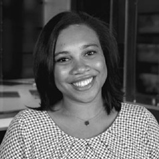
Name—Olivia Steen
Job Title—Reporter/Multimedia Journalist
Employer and Website—WHNT, Huntsville, AL; whnt.com
Social Media Outlets I Use—Facebook, Twitter
Typical Daily Duties—My day usually starts with contacting my connections and different resources just to make sure I’m completely up to date with what is going on in my city. I try to plan for the next day the day before, but I also like to make sure that before I go out on my scheduled stories, I have covered anything that may be of extreme importance.
After calling my references and having our daily morning meeting, I go out on my stories. This includes my interviews and shooting of my video footage. After I have completed my tasks for the day, I go back to the office to write and edit my stories. After everything is done for television, I do my tasks for the web; whether it’s posting to Facebook or Twitter or even our website.
When I’m completely done for the day, I start planning for my next day. I look for story ideas and schedule interviews for those stories. There are days where breaking news can interrupt my schedule, but you have to adjust based on the timeliness of the story.
A parent questions the effect of toxic fumes on local children. The company official tries to reassure the crowd, which clearly is reacting negatively to the idea of building this plant in town. “There is absolutely nothing dangerous about anything we will be burning,” the spokesperson says.
A man stands up holding a newspaper clipping. “Wasn’t your company cited for burning dangerous things in Nebraska?” he asks. “This story says your company left a real mess around and you were burning all sorts of dangerous things improperly.”
The company official tries to explain away the story, saying, “We had a few workers who weren’t doing their jobs the way they should have, but they’ve been replaced and things are all squared away now.”
The man with the paper is still standing. “And this story says that you only employ about a dozen workers at that Nebraska plant. You claim the plant here would mean 100 jobs for our town.”
The debate went on for two hours, but the story prepared by the TV reporter would probably last no more than 90 seconds, maybe a little longer if the meeting took place on a slow news day. The local radio reporter would devote more time to the story because the issue is big news in Wheatland. The radio reporter might do a special in-depth wrap-up of the meeting in addition to some one-minute wraparounds during newscasts throughout the day. There is no local daily newspaper, only a weekly, so the townspeople are anxious to hear as much as they can on the debate.
The videographer with the TV reporter picked up the heated debate and stopped shooting during the dull periods. After a while, a videographer develops a sense for knowing when to start and stop shooting a story like this one. Because the videographer knows that less than a minute of sound bites will make the news, it is unnecessary to shoot continuously.
After shooting the highlights of the debate, the reporter and videographer moved outside and interviewed some people as they left the building. Everyone they spoke with was opposed to the incinerator. In an effort to be as fair as possible, the reporter continued interviewing until she finally found a man who said he was “keeping an open mind on the matter” until he heard more. “If there really would be an extra 100 jobs,” he said, “I’d want to think about it.”
The reporter decided they had enough material. She would have liked to do a separate interview with one of the company representatives, but there was no time. The debate had continued for almost two hours, and the ride back to the station would take 40 minutes. She chose to use part of the official’s remarks for balance and to include some of the debate along with the interviews she conducted outside the building. She also decided to use some of the crowd shots to go along with the sound bites. The company had provided her with a video of the Nebraska plant.
The reporter opened her package with a sound bite. This is known as a cold open, as the first image seen must have audio up full and the graphics operator ready to drop in a quick identifying graphic if needed. The package appeared as follows:
| SOT Woman yelling at meeting | SOT runs:04 “I’m not going to let you put anything in my backyard that’s going to poison my children!” |
| V/O Crowd debating NAT SOUND UNDER | V/O This woman was one of almost 100 people who showed up at a meeting in Wheatland tonight to listen to a proposal. The plan would establish a waste-burning incinerator in this predominantly dairy-farm community of 400 people. |
| SOT Man talking in crowd and waving a newspaper | SOT:12 “I don’t trust your company. This story says your company left a real mess around and you were burning all sorts of dangerous things improperly . . .” |
| V/O shots MEDVAC plant | The company that this man is referring to is the Quadrocare Medvac Waste Disposal Corporation out of Omaha, Nebraska. And there have been published reports that Medvac was fined for not properly disposing of medical waste at its plant outside of Omaha. |
| SOT FONT: Bob Smith CEO, MEDVAC Waste Disposal |
SOT:06 “We did have some trouble for a while, but we’ve corrected all those problems.” (protest from crowd) |
| V/O Angry crowd Video of farms and rolling hills | V/O There was no doubt about the sentiments of most of the people assembled here tonight. These are farm people and the environment—the land they work and the air they and their cows breathe—is precious to them. But many young people have left the farms and are desperate for work in Wheatland. Medvac claims it would hire 100 people at the incinerator it wants to build. |
| SOT Angry man | SOT:08 “And what about these 100 jobs you’re talking about? This story says that you only employ about a dozen workers at that Nebraska plant.” |
| V/O Crowd leaving hall | V/O The debate lasted almost two hours. Most of the attendees protested the idea, but some want to hear more from the company. |
| SOT O/C two-shot | SOT:05 “Well, if it’s true that the plant would bring 100 jobs to town. I’d want to think about it.” |
| V/O Town officials and others talking outside the meeting hall | V/O Town supervisors told Medvac that they would have a decision for them within 30 days. This is Janet Baker reporting from Wheatland. |
This package is a good example of the proper way to cover a local government meeting. Unfortunately, many local reporters cover such stories from the back of the meeting room or on the steps of city hall. In such stories, the opening shot shows the reporter, and then the camera moves from the reporter to the members of the city council or other governing body. In dull fashion, the camera pans from one member to another while the reporter voices the narrative. There usually are no sound bites in the story, just the voice of the reporter and the nameless faces and voices of the town officials.
To avoid such uninteresting stories, the reporter covering local government meetings should find out in advance what is going to be discussed and select the most interesting subject and, if possible, one that lends itself to video footage. For example, let’s consider a story about the extension of sewers to a certain part of town. Before the debate, the reporter and videographer should go to the location, take footage of the area, and speak with some of the residents. Some might like the sewer idea, but others might oppose it because it would mean higher taxes.
Now when the journalist attends that public meeting and reports that the town supervisors voted to extend the sewer system, she can say “Earlier in the day we spoke to some residents of that area, and here’s what they had to say.” The taped comments and video of the area are much stronger than simple footage of the supervisors voting in their boardroom.
VIRTUAL PRESS CONFERENCES
To describe a virtual press conference, a good parallel within a university would be a distance education course in which the professor lectures to a digital camera. His lecture is then transmitted in real time to students at various locations, whether at home, at classrooms on satellite campuses, or on their phones.
Virtual press conferences, which are also known as web conferences, are no different. They have a rudimentary level of interactivity via a “chat” function or instant messaging, either of which allows questions and answers during the presentation or in a designated Q&A period. PowerPoint presentations and slideshows can be transmitted, plus the entire event can be archived and played back for journalists who missed the online session or need a quick review.
The primary drawback is technical, as the webstream’s video image will probably not be of broadcast quality. And if a reporter asks a tough question, the subject can more easily dodge it.
The efficiency of virtual press conferences cannot be denied, especially if the subject is of regional or national interest. For example, through the federal government’s Open Government Initiative of 2009, every federal department is required to expand opportunities for citizen participation, collaboration, and oversight. Such web conferencing is handy for government agencies like the Nuclear Regulatory Commission, which oversees facilities nationwide.
Of course, the rules for covering these events mirror the guidelines for handling live events. Reporters should conduct the applicable background work, have questions prepped in advance, and remember that the public relations expert who orchestrated the event has an agenda to put before the public.
SUMMARY
Reporters spend much of their time covering planned events. Unlike spot news, which is unpredictable, most planned events are known about by the assignment editors days and weeks in advance. These events fill part of the newscast almost every night. A good percentage of planned events are news conferences. Because news conferences are called by people trying to “sell” something, reporters must be prepared to ask tough questions; they cannot allow themselves to be used.
Other common planned events are those provided by the workings of government—town and city council meetings and, in state capitals, meetings of the legislature. Research is important. Reporters must be familiar with the issues under discussion and be ready to ask intelligent questions about them. Planned events are not always exciting; they often have few or no picture opportunities. They are, however, an important part of covering the news, even if they wind up as a 20-second voiceover.
Political events are solid additions to newscasts, even though they are limited to those months before an election is held. It is vital that reporters do not become either cheerleaders or attack dogs against a particular candidate or party; remember that objectivity is the cornerstone of broadcast journalism.
Grand openings are also planned events that are announced well in advance, yet coverage of these is determined by the size of the business. The most important lesson in reporting these stories is that the pivotal moment occurs but once, thus advance setup and position are crucial for the field crew.
The final category of nonbreaking stories is the feature event. These stories give reporters more opportunity to display their creative talents. Every reporter has his or her favorite type of story, but you must remember that you have to learn how to cover them all, regardless of where they will appear in the newscast.
Test Your Knowledge
1. Name some of the planned events that broadcast reporters cover.
2. How do assignment editors determine which planned events they will cover?
3. What are the chief reasons that people and organizations call news conferences?
4. How does a reporter prepare for a news conference?
5. What is the best way for broadcast reporters to cover a town or city council meeting?
6. What is the worst way to cover such a meeting?
7. What are the most important things to remember when covering a political campaign?
EXERCISES
1. Cover a city council or town meeting with a tape recorder or video camera. Prepare a wrap or package.
2. Attend a news conference and prepare a wrap or package.
3. Read a newspaper account of a planned event and then watch a television news report of the same story. In what ways are the stories similar and different?
4. Track down the agenda for an upcoming city council meeting on the city’s website. Estimate how long you think the meeting will last based on the number of agenda items.
